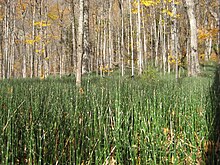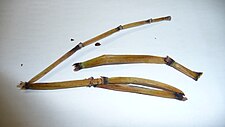rough horsetail
Search
Wikipedia
| Equisetum hyemale | |
|---|---|

| |
|
Scientific classification | |
| Kingdom: | Plantae |
| Clade: | Tracheophytes |
| Division: | Polypodiophyta |
| Class: | Polypodiopsida |
| Subclass: | Equisetidae |
| Order: | Equisetales |
| Family: | Equisetaceae |
| Genus: | Equisetum |
| Subgenus: | E. subg. Hippochaete |
| Species: |
E. hyemale
|
| Binomial name | |
|
Equisetum hyemale | |
| Synonyms | |
|
Hippochaete hyemalis (L.) Bruhin | |
Equisetum hyemale (commonly known as rough horsetail,[1]scouring rush, scouringrush horsetail and, in South Africa, as snake grass) is a perennial herbaceous vascular plant in the horsetail family Equisetaceae. It is a native plant throughout the Holarctic Kingdom, found in North America, Europe, and northern Asia.
Distribution
In nature Equisetum hyemale grows in mesic (reliably moist) habitats, often in sandy or gravelly areas. It grows from between sea level to 2,530 metres (8,300 ft) in elevation.[2]
It is primarily found in wetlands, and in riparian zones of rivers and streams where it can withstand seasonal flooding.[2] It is also found around springs and seeps, and can indicate their presence when not flowing. Other habitats include moist forest and woodland openings, lake and pond shores, ditches, and marshes and swamps.
Description
Equisetum hyemale has vertical jointed reed-like stalks of medium to dark green. The hollow stems are up to 3 feet (0.91 m) in height. The stems are seldom branched. The stems themselves have conspicuous ridges, which are impregnated with silica. This makes the ridges feel rough and harsh.[3][4]
The tiny leaves are joined together around the stem, forming a narrow black-green band or sheath at each joint. Like other ferns and their relatives, the plant reproduces by spores and does not produce flowers or seeds.[3]
The stems are generally deciduous in cold climates,[5] and remain during winter in warmer climates. It forms dense spreading colonies, in full to partial sun.
- Subspecies
Two Equisetum plants are sold commercially under the names Equisetum japonicum (barred horsetail) and Equisetum camtschatcense (Kamchatka horsetail). These are both types of E. hyemale var. hyemale, although they may also be listed as varieties of E. hyemale.
Uses
Domestic
The rough stems have been used to scour or clean pots, and used as sandpaper.[8][9]
Boiled and dried Equisetum hyemale is used as traditional polishing material, similar to a fine grit sandpaper, in Japan.
- Music
The stems are used to shape the reeds of reed instruments such as clarinets or saxophones.
Medicinal
Some Plateau Indian tribes boiled the stalks to produce a drink used as a diuretic and to treat venereal disease.[10]
It is used as a homeopathic remedy.[3]
Cultivation
Equisetum hyemale cultivated as an ornamental plant, for use in contained garden beds and planters, and in pots. It is a popular "icon plant" in contemporary Modernist and Asian style garden design. Its tight verticality fits into narrow planting spaces between walkways and walls, and on small balconies.
It is also used as an accent plant in garden ponds and ornamental pools, and other landscape water features, planted in submerged pots.
The plant is sometimes sold in the nursery trade as "barred horsetail" or "Equisetum japonicum", but is different in appearance than Equisetum ramosissimum var. Japonicum.
Invasiveness
The plant spreads very aggressively by underground runners, reaching under/past pavements and garden walls. Root barriers or large sunken planters ease containment in the garden.[3]
In South Africa and Australia, the plant is an invasive species of moist natural habitats.[11]
References
- ^ BSBI List 2007 (xls). Botanical Society of Britain and Ireland. Archived from the original (xls) on 2015-06-26. Retrieved 2014-10-17.
- ^ a b Jepson
- ^ a b c d Lady Bird Johnson Wildflower Center Native Plant Database: Equisetum hyemale (scouring rush)
- ^ Webb, S.A., Parnell, J. and Doogue, D. 1996. Dundalgan Press (W. Tempest), Dundalk ISBN 0-85221-131-7
- ^ Clapham, A.R., Tutin, T.G. and Warburg, E.F. 1968 Excursion Flora of the British Isles Cambridge University Press ISBN 0 521 04656 4
- ^ Jepson Manual treatment for Equisetum hyemale subsp. affine
- ^ CalFlora Database: Equisetum hyemale subsp. affine
- ^ Johnson, Derek; Linda Kershaw; Andy Mackinnon; Jim Pojar (1995). Plants of the Western Boreal Forest and Aspen Parkland (Digitized online by Google books). Lone Pine Publishing and the Canadian Forest Service. p. 281. ISBN 1-55105-058-7. Retrieved 2009-01-25.
- ^ Wilkinson, Kathleen (1999). Wildflowers of Alberta A Guideto Common Wildflowers and Other Herbaceous Plants. Edmonton Alberta: Lone Pine Publishing and University of Alberta. p. 34. ISBN 0-88864-298-9.
- ^ Hunn, Eugene S. (1990). Nch'i-Wana, "The Big River": Mid-Columbia Indians and Their Land. University of Washington Press. p. 353. ISBN 0-295-97119-3.
- ^ Lifeisagarden.co.za: "Invasive alien plants—Equisetum hyemale."
- USDA Plants Profile: Equisetum hyemale (scouringrush horsetail)
- Flora of North America: Equisetum hyemale
- Missouri Botanical Garden, Kemper Center for Home Gardening — Equisetum hyemale (scouring rush)
- Floridata — Equisetum hyemale.




